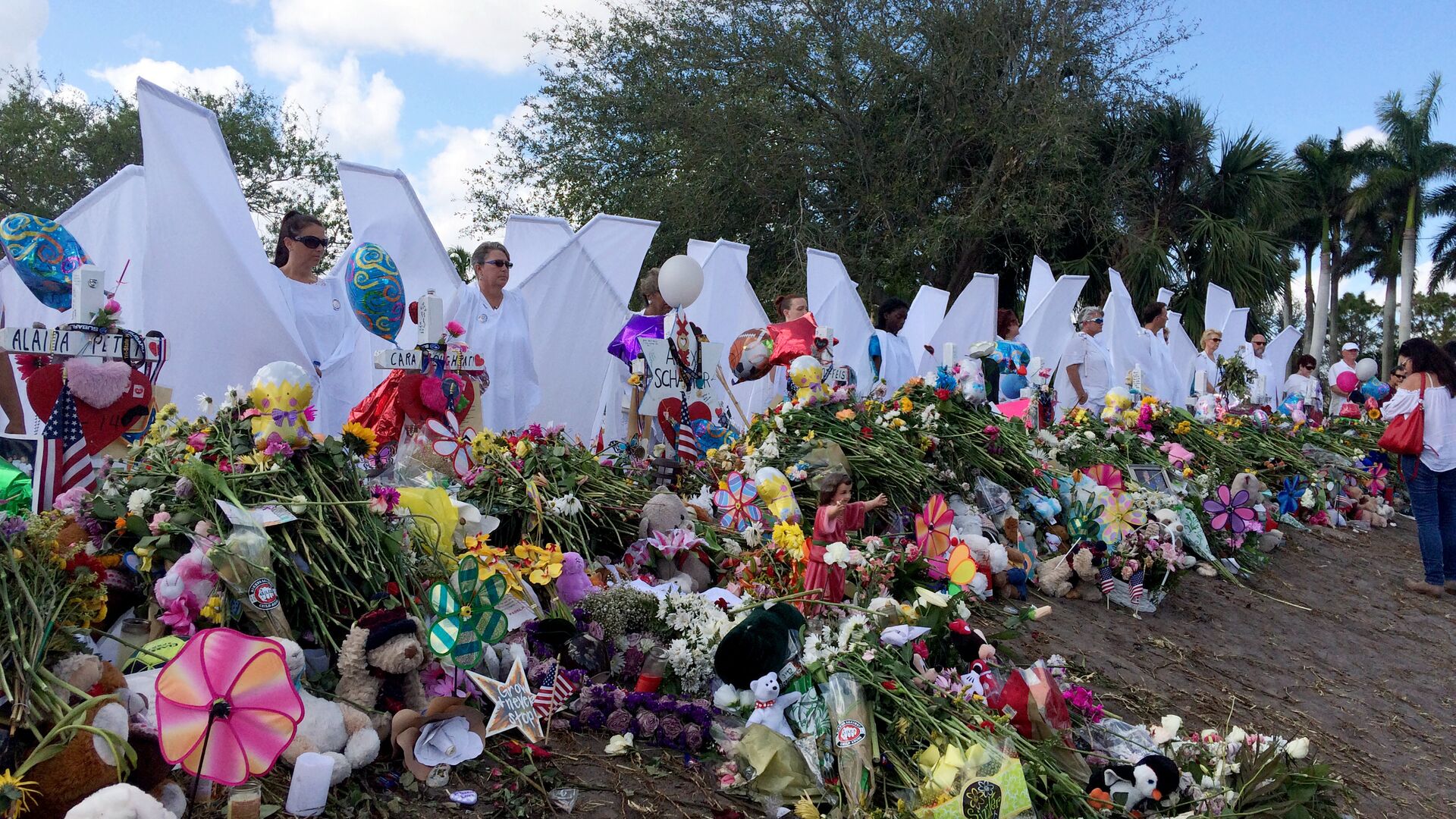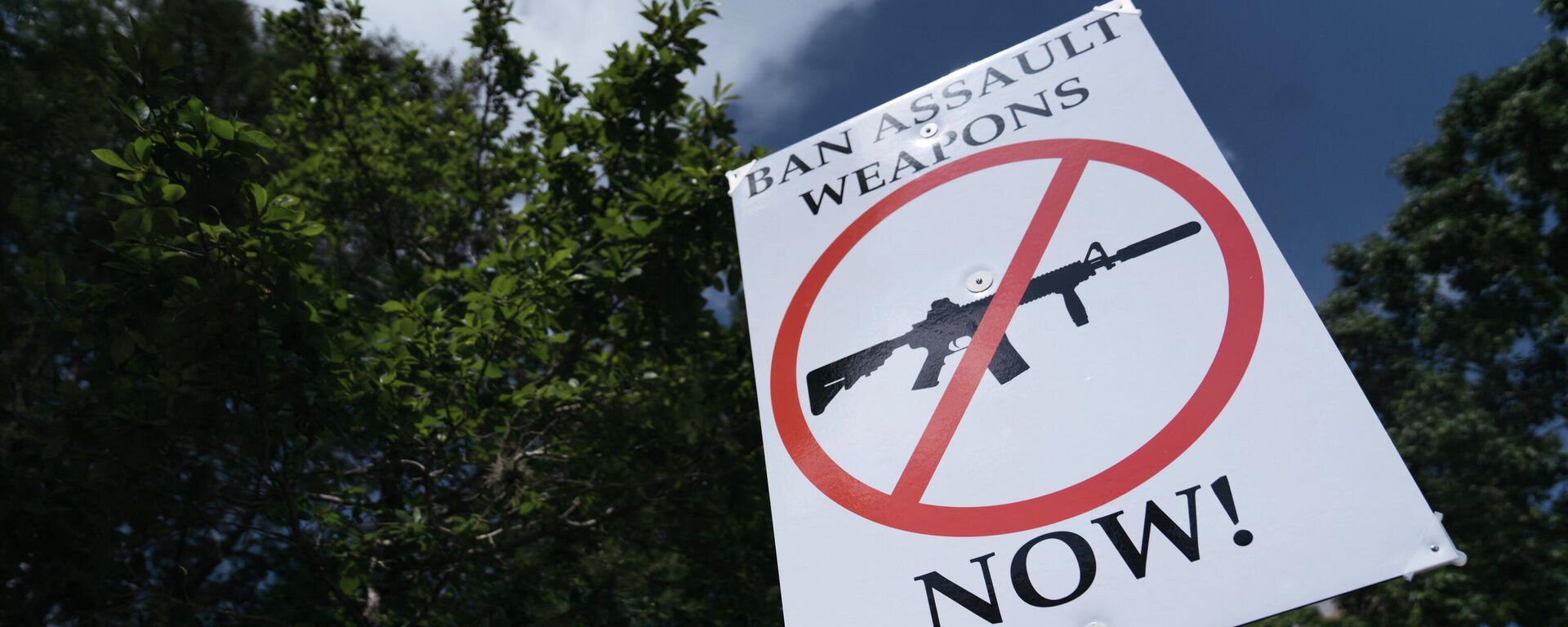https://sputnikglobe.com/20230215/five-years-after-the-parkland-shooting-not-much-has-been-done-to-combat-us-gun-violence-1107443567.html
Five Years After the Parkland Shooting, Not Much Has Been Done to Combat US Gun Violence
Five Years After the Parkland Shooting, Not Much Has Been Done to Combat US Gun Violence
Sputnik International
Five years ago Tuesday, 19-year-old Nikolas Cruz opened fire on students and faculty at Marjory Stoneman Douglas High School in Parkland, Florida. Seventeen people died and another 17 were injured.
2023-02-15T03:47+0000
2023-02-15T03:47+0000
2023-02-15T03:50+0000
analysis
gun violence
mass shootings
school shootings
uvalde
parkland shooting
https://cdn1.img.sputnikglobe.com/img/106198/78/1061987884_0:306:3264:2142_1920x0_80_0_0_cfd2af606c8ea79ce3d1d04e6044f256.jpg
Five years after the Parkland massacre, where are we in our quest to end school shootings, and is there a light at the end of the tunnel?The massacre caused an outburst of protests and activism, led by some of the survivors of the shooting. Students Cameron Kasky, Alex Wind, David Hogg, and X González organized and led a protest dubbed “March for our lives” that same year, supercharging the debate on national gun control.Since the Parkland massacre, politicians have promised action. Republicans have promised more access to mental health care, placing the blame for the shootings on mental deficiencies in the populace and, significantly, off of guns. Democrats, meanwhile, have proposed a variety of gun control laws, but have been unable to pass even popular regulations that have real teeth.After the Uvalde massacre in 2022, which resulted in the death of 19 children and two teachers, some progress toward gun control was made, but it has not slowed down school shootings.So far in 2023, there have been six school shootings in K-12 schools either during class or an after-school event. That number does not include shootings on college campuses, like the Michigan State University shooting that killed three people on Monday. In 2022, including the Uvalde massacre, there were 51 school shootings with injuries or deaths, the worst year since media outlets started tracking that number in 1999 after the Columbine mass shooting.The Uvalde massacre, along with several other mass shootings, did enough to convince Congress they couldn’t avoid the issue any longer. On June 25, President Biden signed the Bipartisan Safer Communities Act, the first significant federal gun safety regulation to pass since the assault weapons ban of 1994, which was allowed to expire in 2004.The law gave states $750 million to implement a variety of crisis intervention programs, including red-flag programs that allow courts to temporarily seize weapons from someone believed to be a danger to others, but the legislation largely allowed states to spend that money how they wished.The bill also cracked down on who has to register as a Federal Licensed Firearm Dealer, lowering the requirement to anyone who sells guns as a primary source of income. It also required that juvenile records be included for background checks on gun purchasers aged 18-21, limited gun ownership for anyone convicted of domestic violence, and cracked down on “straw purchases,” which is when someone buys a gun for someone not legally able to purchase one.Additionally, at least 11 states implemented their own gun regulation laws. Most of the laws focused on increased background checks, prohibiting ghost guns, outlawing high-capacity magazines, or limiting where guns can be carried.Two Republican-led states responded to the crises without gun legislation. Florida, in response to Parkland, allowed some teachers to be armed in the classroom and Texas, in response to Uvalde, authorized $110 million for “school safety.”But a state-by-state piecemeal solution has proven ineffective. There are no physical borders between states. A gun purchased in Texas can easily be carried into California. While studies have shown some correlation between lax-gun laws and increased gun violence within the United States, it is clear by how much violence still happens even in the strictest states that a state-by-state solution is insufficient.Second, many of the school safety measures are questionable in their effectiveness. For example, of the $110 million the Texas legislature set aside for school safety, more than half of it went to ballistic shields for campus police officers. But those shields are unlikely to help in an active shooter situation because officers are trained to engage the shooter immediately, not head to their office for their shield.Additionally, planning and security measures are oftentimes already known by the shooter who, in the vast majority of school shootings, is either a current or former student. No amount of preparation will help if the shooter knows the plan as well as anyone else.While solutions like bullet-proof furniture sound good in theory, they could just as easily be used by the shooter to protect themselves from police.The experience of going through a lockdown, as 4.1 million students did in the 2017-2018 school year due to either campus violence or the threat of violence, can also cause stress and anxiety. If mental health truly is at the heart of school shootings, making institutions of learning feel more like a prison is not likely to help the situation.What may help the situation, is something Congress hasn’t truly attempted since 1994: comprehensive gun control on the federal level.“We need to put our politics aside, and get something done,” Hogg told CBS in a recent interview, “because ultimately, it doesn't matter if you're a Republican or a Democrat, we all have people that we care about, and none of us want gun violence to continue.”
https://sputnikglobe.com/20230214/what-do-we-know-about-the-deadly-michigan-state-university-shooting-1107439295.html
https://sputnikglobe.com/20220626/biden-signs-first-gun-control-legislation-in-decades-1096663637.html
https://sputnikglobe.com/20220629/two-thirds-of-americans-support-tighter-gun-control-laws-poll-shows-1096806985.html
uvalde
Sputnik International
feedback@sputniknews.com
+74956456601
MIA „Rossiya Segodnya“
2023
News
en_EN
Sputnik International
feedback@sputniknews.com
+74956456601
MIA „Rossiya Segodnya“
Sputnik International
feedback@sputniknews.com
+74956456601
MIA „Rossiya Segodnya“
parkland shooting, anniversary, uvalde shooting, marjory stoneman douglas, florida, texas, david hogg
parkland shooting, anniversary, uvalde shooting, marjory stoneman douglas, florida, texas, david hogg
Five Years After the Parkland Shooting, Not Much Has Been Done to Combat US Gun Violence
03:47 GMT 15.02.2023 (Updated: 03:50 GMT 15.02.2023) Five years ago Tuesday, 19-year-old Nikolas Cruz opened fire on students and faculty at Marjory Stoneman Douglas High School in Parkland, Florida. Seventeen people died and another 17 were injured. Cruz has since been sentenced to life in prison without parole.
Five years after the Parkland massacre, where are we in our quest to end school shootings, and is there a light at the end of the tunnel?
The massacre caused an outburst of protests and activism, led by some of the survivors of the shooting. Students Cameron Kasky, Alex Wind, David Hogg, and X González organized and led a protest dubbed “March for our lives” that same year, supercharging the debate on national gun control.
“When politicians send their thoughts and prayers with no action, we say ‘no more!’” Hogg famously said at the protest.
Since the Parkland massacre, politicians have promised action. Republicans have promised more access to mental health care, placing the blame for the shootings on mental deficiencies in the populace and, significantly, off of guns. Democrats, meanwhile, have proposed a variety of gun control laws, but have been unable to pass even popular regulations that have real teeth.
After the Uvalde massacre in 2022, which resulted in the death of 19 children and two teachers, some progress toward gun control was made, but it has not slowed down school shootings.
So far in 2023, there have been
six school shootings in K-12 schools either during class or an after-school event. That number does not include shootings on college campuses, like the Michigan State University shooting that killed three people on Monday. In 2022, including the Uvalde massacre, there were 51 school shootings with injuries or deaths, the worst year since media outlets started tracking that number in 1999 after the Columbine mass shooting.

14 February 2023, 22:05 GMT
The Uvalde massacre, along with several other mass shootings, did enough to convince Congress they couldn’t avoid the issue any longer. On June 25, President Biden signed the Bipartisan Safer Communities Act, the first significant federal gun safety regulation to pass since the assault weapons ban of 1994, which was allowed to expire in 2004.
The law gave states $750 million to implement a variety of crisis intervention programs, including red-flag programs that allow courts to temporarily seize weapons from someone believed to be a danger to others, but the legislation largely allowed states to spend that money how they wished.
The bill also cracked down on who has to register as a Federal Licensed Firearm Dealer, lowering the requirement to anyone who sells guns as a primary source of income. It also required that juvenile records be included for background checks on gun purchasers aged 18-21, limited gun ownership for anyone convicted of domestic violence, and cracked down on “straw purchases,” which is when someone buys a gun for someone not legally able to purchase one.
Additionally, at least 11 states implemented their own gun regulation laws. Most of the laws focused on increased background checks, prohibiting ghost guns, outlawing high-capacity magazines, or limiting where guns can be carried. Two Republican-led states responded to the crises without gun legislation. Florida, in response to Parkland, allowed some teachers to be armed in the classroom and Texas, in response to Uvalde, authorized $110 million for “school safety.”
But a state-by-state piecemeal solution has proven ineffective. There are no physical borders between states. A gun purchased in Texas can easily be carried into California. While studies have shown some correlation between lax-gun laws and increased gun violence within the United States, it is clear by how much violence still happens even in the strictest states that a state-by-state solution is insufficient.
Second, many of the school safety measures are questionable in their effectiveness. For example, of the $110 million the Texas legislature set aside for school safety, more than half of it went to ballistic shields for campus police officers. But those shields are unlikely to help in an active shooter situation because officers are trained to engage the shooter immediately, not head to their office for their shield.
Additionally, planning and security measures are oftentimes already known by the shooter who, in the vast majority of school shootings, is either a current or former student. No amount of preparation will help if the shooter knows the plan as well as anyone else.
While solutions like bullet-proof furniture sound good in theory, they could just as easily be used by the shooter to protect themselves from police.
The experience of going through a lockdown,
as 4.1 million students did in the 2017-2018 school year due to either campus violence or the threat of violence, can also cause stress and anxiety. If mental health truly is at the heart of school shootings, making institutions of learning feel more like a prison is not likely to help the situation.
What may help the situation, is something Congress hasn’t truly attempted since 1994: comprehensive gun control on the federal level.
“We need to put our politics aside, and get something done,” Hogg told CBS in a recent interview, “because ultimately, it doesn't matter if you're a Republican or a Democrat, we all have people that we care about, and none of us want gun violence to continue.”





